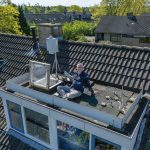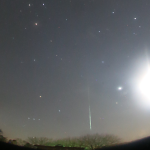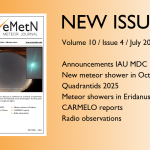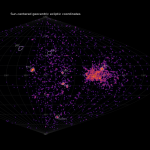Abstract: A summary of the activity of the CAMS-BeNeLux network during the month of January 2023 is presented. This month had many cloudy nights due to a persistent moisty type of weather. A total of 6762 multi-station meteors were recorded, good for 2291 orbits.
Introduction
It is well known that January usually isn’t a month with high scores for our network. Meteor activity is still at a fairly good level, but the weather isn’t cooperating most of the time. 2023 wasn’t an exception.
January 2023 statistics
January 2023 was again a very mild month for our region, with a mean temperature above 5 degrees Celsius. As in 2022, this is not a good sign for astronomical observations. Observations of our network were hampered by clouds during many nights. Complete clear nights were very rare this month for most parts of the BeNeLux.
We had 4 cloudy nights in a row from January 22–23 till 25–26. January 24–25 was completely overcast in the whole of the BeNeLux, with not a single captured meteor by all our cameras as a result.
The major stream Quadrantids was missed in bad weather: on January 3–4, when the highest meteor activity from this stream can be expected, we could add only 3 orbits to our database. The night before we could collect 256 orbits, but Quadrantid-activity always shows a sharp peak of short duration, so this stream wasn’t very obvious during this night (Figure 1).
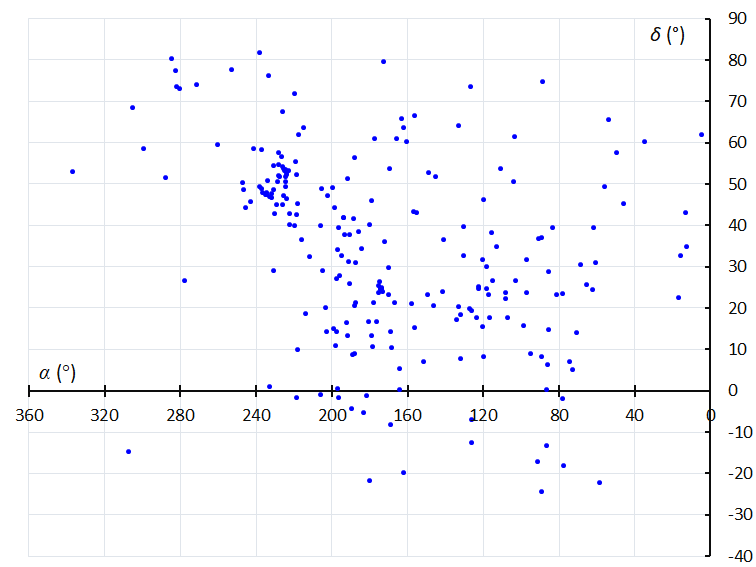
Figure 1 – Radiantplot in geocentric equatorial coordinates for the orbits obtained January 2–3, 2023 (data CAMS-BeNeLux).
What a contrast with for example 2020, when the night of January 3–4 was clear for most parts of the BeNeLux. That night we could collect 640 orbits. Quadrantid activity was abundant that night. (Figure 2).
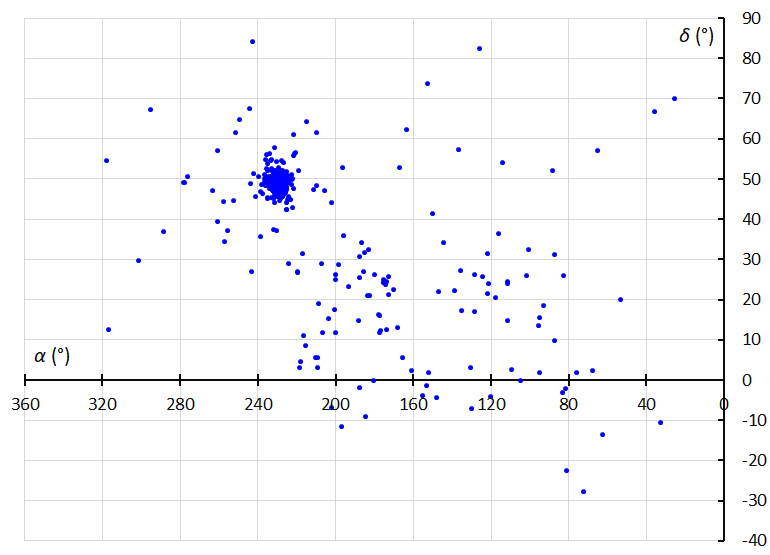
Figure 2 – Radiantplot in geocentric equatorial coordinates for the orbits obtained January 3–4, 2020 (data CAMS-BeNeLux).
Nevertheless, CAMS-BeNeLux collected 6762 multi-station meteors this month, resulting in a total of 2291 orbits. For January this is a new record, despite 6 nights this month with not a single orbit. The reason for this higher score is the increase in the number of cameras this month when compared to one year ago, as can be seen in Table 1 and Figure 3.
Unfortunately, many stations in the northern parts of the Netherlands are still suffering problems. We hope that this situation improves in the course of this year.
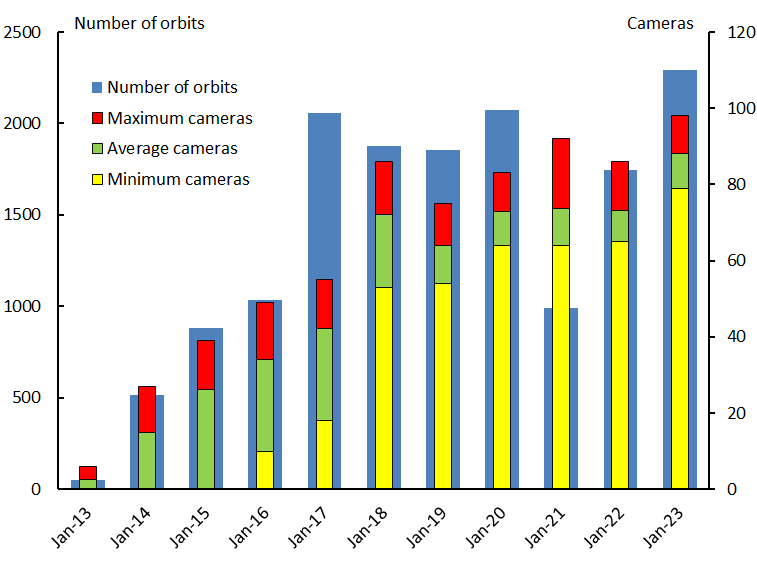
Figure 3 – Comparing January 2023 to previous months of January in the CAMS-BeNeLux history. The blue bars represent the number of orbits, the red bars the maximum number of cameras capturing in a single night, the green bars the average number of cameras capturing per night and the yellow bars the minimum number of cameras.
Table 1 – Number of orbits and active cameras in the BeNeLux during the month of January in the period 2013–2023.
| Year | Nights | Orbits | Stations | Max. Cams | Min. Cams | Mean Cams |
| 2013 | 7 | 49 | 6 | 6 | – | 2.6 |
| 2014 | 21 | 514 | 11 | 27 | – | 14.8 |
| 2015 | 22 | 880 | 14 | 39 | – | 26.1 |
| 2016 | 25 | 1037 | 15 | 49 | 10 | 34.0 |
| 2017 | 23 | 2058 | 18 | 55 | 18 | 42.3 |
| 2018 | 25 | 1878 | 22 | 86 | 53 | 72.0 |
| 2019 | 22 | 1857 | 20 | 75 | 54 | 64.0 |
| 2020 | 23 | 2075 | 21 | 83 | 64 | 72.9 |
| 2021 | 22 | 991 | 26 | 92 | 64 | 73.7 |
| 2022 | 28 | 1744 | 26 | 86 | 65 | 73.2 |
| 2023 | 25 | 2291 | 32 | 98 | 79 | 88.1 |
| Total | 243 | 15374 |
Conclusion
The results for January 2023 are the best in the history of CAMS-BeNeLux.
Acknowledgment
Many thanks to all operators in the CAMS-BeNeLux network for their work and quick delivery of data. In January 2023 the CAMS-BeNeLux network was operated by the following volunteers:
Hans Betlem (Woold, Netherlands, CAMS 3071, 3072, 3073, 3074, 3075, 3076, 3077 and 3078), Jean-Marie Biets (Wilderen, Belgium, CAMS 379, 380, 381 and 382), Ludger Boergerding (Holdorf, Germany, RMS 3801), Günther Boerjan (Assenede, Belgium, RMS 3823), Martin Breukers (Hengelo, Netherlands, CAMS 320, 321, 322, 323, 324, 325, 326 and 327, RMS 319, 328 and 329), Seppe Canonaco (Genk, RMS 3818 and 3819), Pierre de Ponthiere (Lesve, Belgium, RMS 3816 and 3826), Bart Dessoy (Zoersel, Belgium, CAMS 804, 805 and 806), Tammo Jan Dijkema (Dwingeloo, Netherlands, RMS 3199), Isabelle Ansseau, Jean-Paul Dumoulin, Dominique Guiot and Christian Walin (Grapfontaine, Belgium, CAMS 814 and 815, RMS 3814 and 3817), Uwe Glässner (Langenfeld, Germany, RMS 3800), Luc Gobin (Mechelen, Belgium, CAMS 3890, 3891, 3892 and 3893), Tioga Gulon (Nancy, France, CAMS 3900 and 3901), Robert Haas (Alphen aan de Rijn, Netherlands, CAMS 3160, 3161, 3162, 3163, 3164, 3165, 3166 and 3167), Robert Haas (Texel, Netherlands, CAMS 811), Kees Habraken (Kattendijke, Netherlands, RMS 3780 and 3781), Klaas Jobse (Oostkapelle, Netherlands, CAMS 3030, 3031, 3032, 3033, 3034, 3035, 3036 and 3037), Carl Johannink (Gronau, Germany, CAMS 3100, 3101, 3102), Reinhard Kühn (Flatzby, Germany, RMS 3802), Hervé Lamy (Dourbes, Belgium, CAMS 395, RMS 3825 and 3841), Hervé Lamy (Humain, Belgium, RMS 3821 and 3828), Hervé Lamy (Ukkel, Belgium, CAMS 393), Koen Miskotte (Ermelo, Netherlands, CAMS 3051, 353 and 354), Pierre-Yves Péchart (Hagnicourt, France, RMS 3902 and 3903), Tim Polfliet (Gent, Belgium, CAMS 396, RMS 3820 and 3840), Steve Rau (Zillebeke, Belgium, CAMS 3850 and 3852, RMS 3851 and 3853), Paul and Adriana Roggemans (Mechelen, Belgium, RMS 3830 and 3831, CAMS 3832, 3833, 3834, 3835, 3836 and 3837), Jim Rowe (Eastbourne, Great Britain, RMS 3829), Philippe Schaack (Roodt-sur-Syre, Luxemburg, RMS 3952), Hans Schremmer (Niederkruechten, Germany, CAMS 803), Jan Thoemel (Luxemburg, Luxemburg, CAMS 3950), Erwin van Ballegoij (Heesh, Netherlands CAMS 3148 and 3149).


